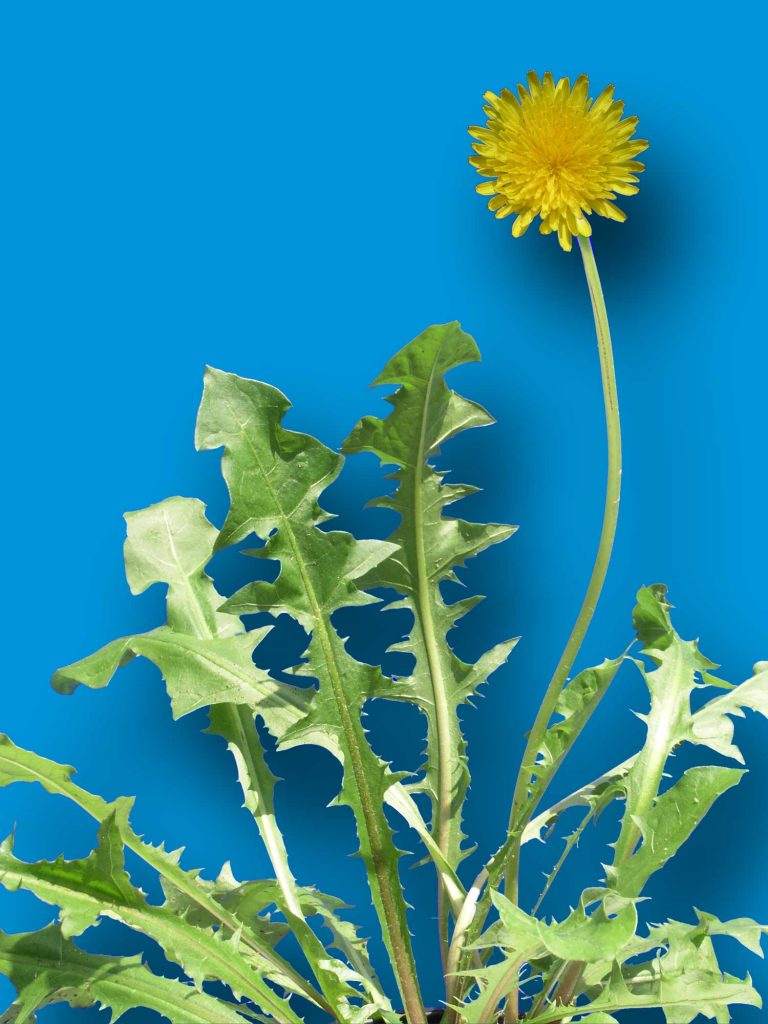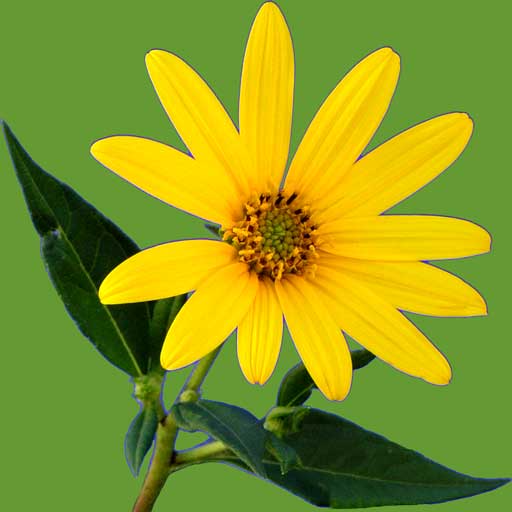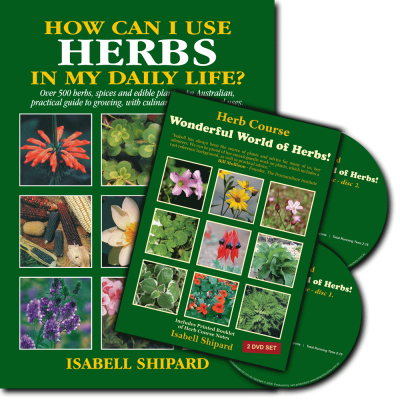Piss-in-bed, Lion’s Tooth, Puff Ball, Cankerwort, Prince in Paupers Clothing, Royal Herb
Taraxacum officinale F. Asteraceae
Description
Perennial with rosette of leaves to 30cm long. Smooth leaves are bright green with uneven, jagged margins of backward pointing teeth, and for this reason the plant has been given the name dandelion which comes from the French ‘dent de lion’, meaning lion’s tooth. Hollow flower-stem to 30cm with one terminal yellow daisy, which sets into a puffball-looking seedhead, with fluffy parachutes to carry each seed away in the wind, nature’s way of plant preservation.

Propagation is by seed, and dandelion will grow under almost all conditions, thriving in dry areas, just as well as it handles the wet conditions. Dandelion will also grow in shade, although this plant family, the daisy, is always considered a sun lover. True dandelion should not be confused with Hawkbit (Leontodon Taraxocoides) or several Cats’ Ears species (Hypochoeris glabra and radicata) which is easily mistaken and is often found in lawns. The identifying points of dandelion are: pointed leaves, only one flower per stem, hollow stems and no hairs on the plant. Note, too, that although some look alike plants are often eaten; long-term use is not advisable. Recently, I had a lady call seeking true dandelion, as it is a valuable herb for horse health. Together with her husband, they run equestrian courses throughout Australia. She said, false dandelions can cause string holt in horses, which shows as jerky movements, freezing of muscles and seizures, as the kidneys cannot flush out the effect of the weed.
Dandelion plants are said to breathe out ethylene gas. Although this can have an inhibiting effect on the growth of some plants nearby, this same gas is utilized by some farmers to accelerate the ripening process of crops. By scattering dandelion seeds under fruit trees, the ethylene gas given off can aid in the early ripening of the crop, which can bring a higher price for fruit early in the season.
Constituents:
essential oil, inulin, levulin, choline, taraxacin, mucin, saponins, resin, fatty acids, sugars, pectin, gum, protein 16.5%
Vitamins:
A, B1, B2, B3, C, E
Minerals:
rich in calcium, chromium, iron, magnesium, manganese, phosphorus, potassium, sodium, selenium, silicon, zinc
Actions:
diuretic, laxative, choleretic, tonic, stomachic, antioxidant, hepatic, alterative, aperient, anti-inflammatory, cholagogue
Medicinal Uses
Dandelion is a valuable herb, originating in Europe, but now naturalised in many countries, largely due to wind disposal of the seed. This may be nature’s way of telling us it is readily available for us all to use regularly, as the plants’ properties are so valuable. Dandelion has been a revered herb throughout history, regarded as one of the very best herbs known for gall, spleen and liver complaints, and one of the safest and most active plant diuretics. The common name Piss-in-bed, which comes from the French word ‘pissenlit’, indicates the herb’s habit of giving the kidneys the urge to expel urine. Women, who find they puff up at the time of menstruation, may get considerable relief from bloating and breast tenderness, by drinking dandelion tea, as soon as they feel these symptoms.
A daily tea of dandelion root, or eating the leaves, is recommended for anyone with liver complaints. It can be eaten regularly as a preventative, helping to keep the liver at peak efficiency. As the green leaves are a valuable alkaliser to the body, eaten regularly they assist the body to reduce excess acidity; oxygenate, purify and build blood; cleanse and regenerate cells. The bitter principles stimulate the digestion (by salivation, and the production of stomach acids and enzymes); assist liver, spleen, gall and pancreas function, and make it easier to digest fats and oils. Dandelion has been found to stimulate mucus membranes, sooth the digestive tract, absorb toxins from the bowel, help friendly flora to thrive and inhibit unfriendly bacteria. Eating dandelion regularly has a reputation of relieving diabetes. The following blend of herbs put in 00 capsules, and one taken after each meal is found to be beneficial: 2 parts dandelion, 1 part fennel, 1/2 part ginger and 1 part elecampane. It is said that dandelion leaves consumed daily in salads can dissolve gallstones.
Dandelion is helpful for people who suffer from allergies, eczema and other skin conditions, asthma, arthritis, gout, rheumatism, gall stones, metabolic disturbances, bone disorders, low blood pressure, poor circulation, ulcers, anemia, halitosis (bad breath), constipation, malignant tumors, colds, lowering cholesterol, cardiac edema, heart burn, swollen glands, hot flushes, and as a sleep inducing night cap. Dandelion is a herb with fat metabolising properties. For weight loss several cups of dandelion tea can be sipped daily, adding 1-2 tablesp. of cider vinegar to each cup. Therapeutically, dandelion can be used as leaf or root tea, a tincture, or the fresh leaves blended with vegetables or fruit juices. An infusion of 1 teasp. of root to 1 cup of water may be prepared and taken freely (several cups a day). Sweeten with honey if desired. 5-6 fresh leaves to 1 cup of boiling water, left to steep 5-10 minutes, can be used similarly. A wash to relieve inflamed eyes and also applied to facial blemishes is made with dandelion leaves, stems and flowers. The white sap from the stems placed on warts several times a day will be a powerful way to tell them to shrivel and disappear.
Sometime ago, a lady from Victoria called at the farm and shared with me that a while ago she had been diagnosed with a rare kidney disease and had been given only 2 months to live. The lady told me how upon diagnosis she began eating raw dandelion leaves and roots daily. She cured herself of the disease and was now able to enjoy a holiday in Queensland. Maria Treben in ‘Health through God’s pharmacy’ esteems dandelion for disorders of the pancreas, liver, gall, spleen and blood. From her experiences, she has seen how valuable this humble herb (that most people call a weed), has been to many people who suffer with diabetes. Besides eating a dandelion salad with two meals daily in spring, Maria encourages the eating of 10 flower stems for 4 weeks to reduce the sugar level in the blood. The stems are chewed slowly and will taste bitter to start with, but the body starts to appreciate it. People, who lack energy and feel constantly tired or sick, will benefit with using dandelion stems for a 14-day course.
Dandelion goes into a revered mix for cleansing the kidneys, liver and for cancer treatment. To prepare: take enough dandelion leaves to hold in the ring of thumb and finger, 8 good sized leaves of comfrey, 10 marshmallow leaves (violet or peach leaves can be substituted) 1 large cup full of alfalfa leaves. Place in a blender with two 850g cans of unsweetened pineapple juice and blend. Keep in non-airtight container in the refrigerator. Take 225ml (1cup) morning and evening, chewing before swallowing. Take for 5 weeks; and during this time, take any amount of diluted dark grape juice.
Culinary Uses
The highly nutritious, young dandelion leaves are used daily in salads, steamed, added to stir-fries and many other dishes which call for greens. It was a traditional spring cleaning herb, regarded as a valuable blood builder. If leaves are found too bitter, try blanching leaves by covering plants in the garden with a bucket or box, and new leaves that shoot will be pale in colour and mild in flavour. Try steaming older leaves (also called blanching) which will remove the majority of the bitter flavour, and these limped leaves can then be used in salads or other dishes.
A tasty salad of dandelion leaves, tossed with olive oil, a squeeze of lemon juice, chopped chives, parsley and garlic, will be enjoyed by most people interested in natural health. Tossing dandelion leaves and a little vinegar through fried onions, garlic and bacon makes an enjoyable meal, served on toast. Add leaves to omelettes and fritters. Home brewed dandelion beer or wine is another way of getting the benefits of dandelion. Try flowers dipped in batter and fried or flower petals sprinkled in soups.
If dandelions have done well in your garden, self-seeded and produced a bountiful crop of weeds, why not use the roots to make a non-caffeine coffee. Wait until the plants are about 9-12 months old so that the roots are of good size; dig, wash, cut, dry, and then slowly roast in oven until the pieces are a coffee colour. Grind when ready to use. A pinch of salt helps to heighten the flavour and the coffee may be drunk with milk and sweetened with honey. It is said the age of the roots and the length of time roasted has a bearing on the creation of a full coffee flavour.
… … omitted text, please see How can I use HERBS in my daily life? for full text.
And for a light-hearted story … A man can let his wife know he loves her by giving her a dozen large roses, while his small grandson can do the same with a fistful of dandelion flowers!
Perhaps, we all need to appreciate the true value of dandelion.




